Experience-Seeds-Knowledge-Plant Discoveries-Ecological Enrichment-Join Now Click Here!


New Seed Selections-Diversity on a Global Scale
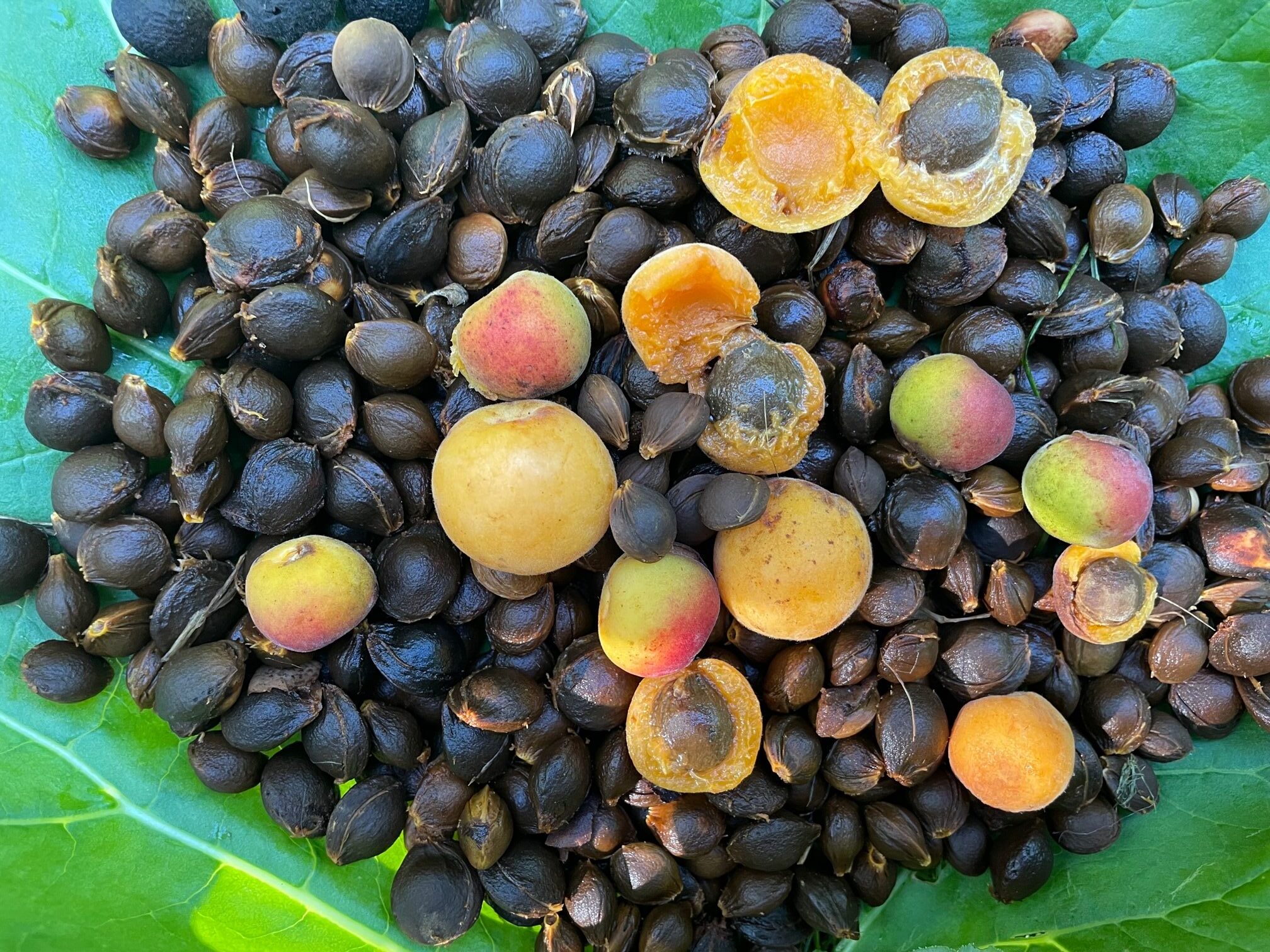
This year was a great surprise of both quantity and diversity of fruit and nuts. I focused my attention on some of the most difficult to find selections as well as improvements I have done or found over the years on new woody and perennial crops. Some of these crops are not found within the seed or plant trade here in the United States. I just began processing the apple and pear seed crops and have began collecting and naming new persimmon varieties. There was a fantastic acorn crop. Many of these go back forty years ago when I began my oak quest for both edible acorns and vigorous hybrid trees from populations.
Above and below is the image of seeds and fruits of the Briana apricot. Unlike the Manchurian apricot this species is adapted to both colder and warmer climates and has a long life as a seed tree for fruits and nuts. In this unusual set of growing circumstances you could say “Not Improved” as it was originally came from an arboretum planting found as an heirloom in someone’s back yard in a land far far away. The most vigorous seedlings are also the most productive and fruit every year despite frost. Part of this is due to the short window of time when the plant is in full flower when it sets fruit. It is more consistent than all the other apricots from seeds I grow. I grew out three generations to see what would happen. Prunus sibirica
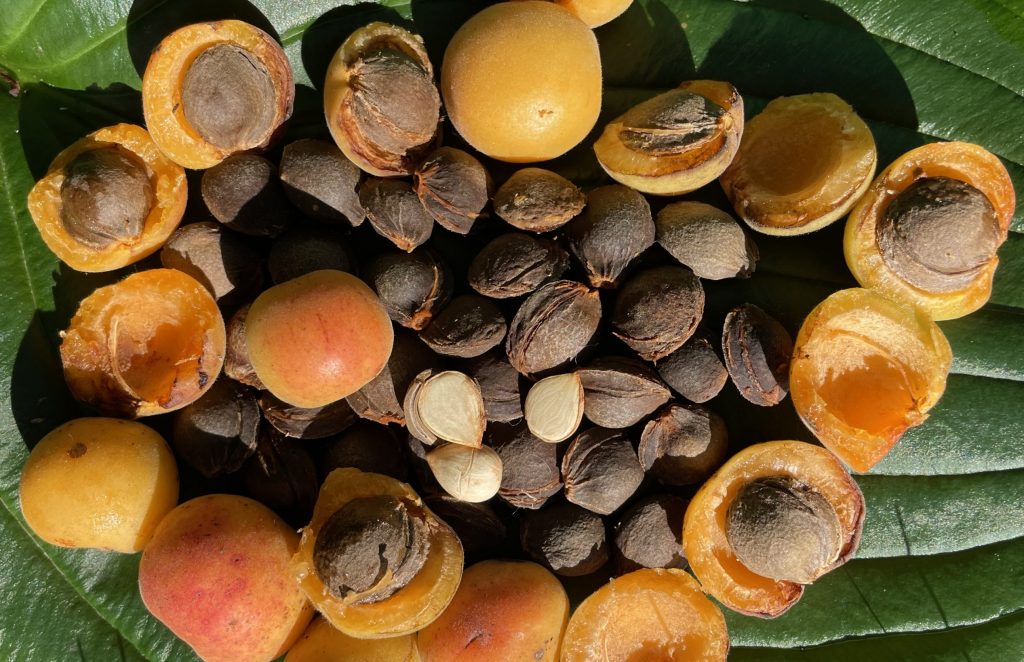
Here are a few seeds recently harvested in 2023.
Nuttall Oak Ecos Willow Red Oak Greatfull Oak Bebbs Oak
Chestnut Oak Chinese Cork Oak Chestnutleaf Oak Ecos Sawtooth Oak
Ecos Beach Plum Nana Beach Plum Wild Texas Peach Mirabelle Plum
Yellow Ussuri Plum Briana Apricot Ocean Blue Sloe Plum Bright Sky Plum
Kerr Applecrab Antonovka Apple Ecos Red Crabapple Hewes Apple
Amur Grape Blue Blaze River Grape Thicket Bean-Perennial Bean
Perpetual Diversity Perennial Potato Purple Ease Potato
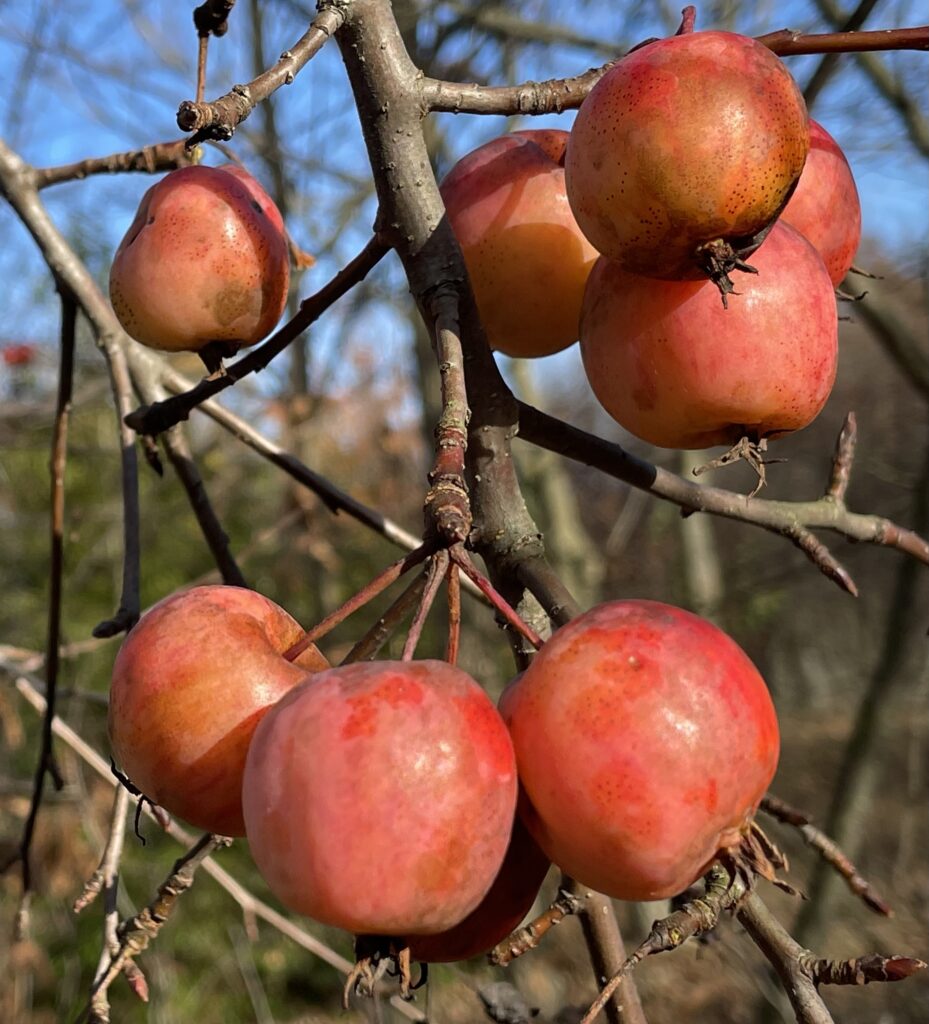
Hewes apple seedling. This particular species is very useful for its rich flavor, insect resistance and heavy production of small fruit. Hewes is a cultivar apple but can be source of a species crab apple native to the southeastern U.S. Often it is listed as a species called Malus angustifolia. In order to quasi stabilize it, I grew three generations of it and selected for both leaf and fruit health.
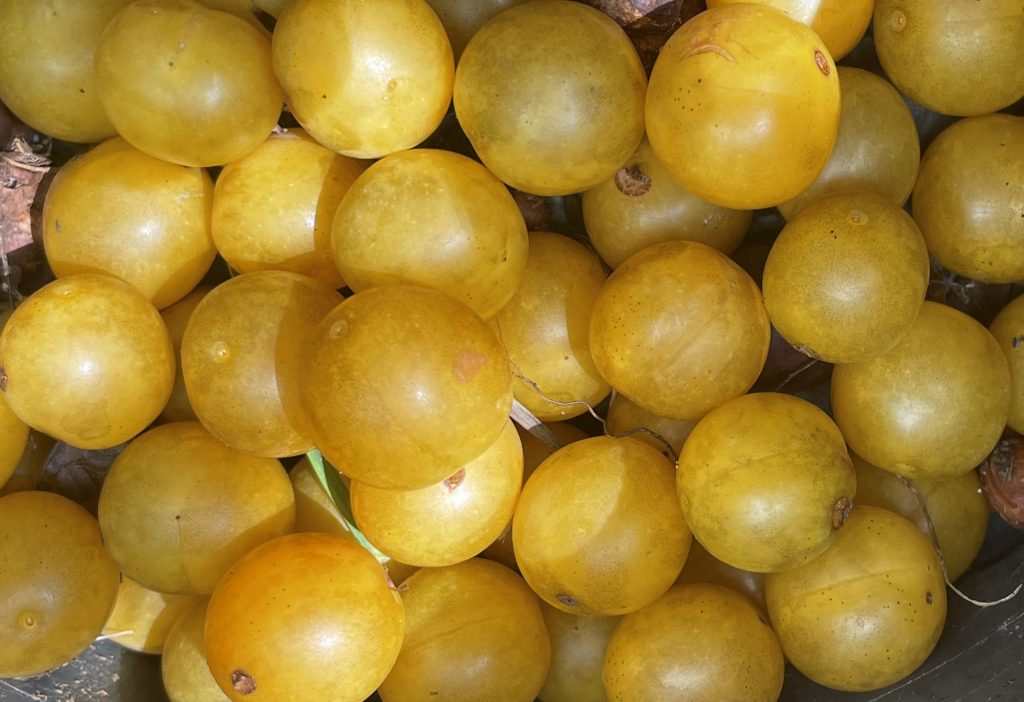
Mirabelle plum represents a species plum that can be grown from seed as an orchard crop. Its heavy yield as ease of production make it a perfect candidate for a low input orchard crop with an amazing flavor profile unique to plums.
One of the goals of my seed collections since closing the nursery is for the establishment of new populations outside of my farm in Michigan. I tried to make it so the quantities allow enough seeds for propagation or sale as well as establishment of an acre or more of each species of plant. Because of international phytosanitary and regulatory issues, I am confined to the United States, but there is a real need globally for the same seed sources I grow. I am constantly getting requests. It is universal in terms of finding and defining new seed strains and crops derived from them as well from a cultivar level too. Some of these crops are hard to source in their native countries as well. The creation of new selections and species is most strong in the organic production of fruits. It is interesting that the fastest growing segment of agriculture is often the most ignored in terms of meeting the needs of low or no input crops for organic crops for fruits. Some attention is paid to the production of vegetables but not woody plants to any extent. You can improve both the quality and diversity of any crop easily using simple methods in a short period of time. It doesn’t have to be a huge breeding fiasco taking decades. So much money is wasted in this arena. Frankly, I don’t think we have the luxury of time anymore. A broader application of creating new edible plant varieties is needed where it becomes more or less crowd sourced as well as making it possible for anyone to forage and use wild fruits in these same plantings especially if they are on public land. If it so much more of a creative use of the land for people than a pseudo-prairie or natives only where even walking is not allowed. I’ve been to a few open spaces like this including ones poisoned by herbicides.
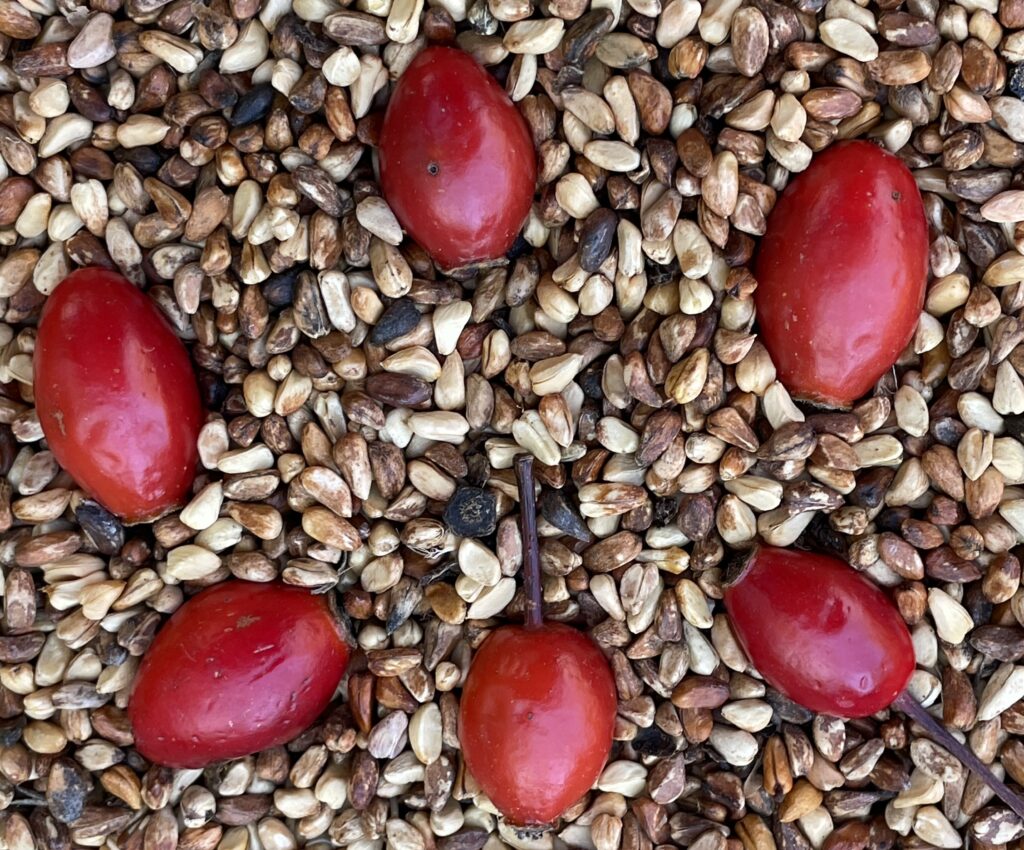
Selected species rose Big Hip rose useful for heavy and delicious fruit production. Seeds have use for oil extraction for the cosmetic industry. These have far better flavor than other species roses both native and non native.
Not too long ago an article came out in a nursery industry magazine describing the shortage of seedling trees and shrubs. Some are specific types of plants that are often produced by small nurseries but not found in large numbers needed for more large scale tree plantings. There is a growing need for many more trees for these large scale projects involving agroforestry and regenerative agriculture. The author said he was going to get to the bottom of this problem. He poetically described the disconnect between a retired or ‘old’ person picking seeds for extra income and a big industry in need of large amounts of seeds. Why is it like this? This brought back memories of me collecting acorns in the parks. I remember selling seeds to seed companies and nurseries when I first started my farm when I had excess seeds from my collecting forays. Even today I am still offered a price for bulk seed on certain species I cultivate at my farm. I would love to do it but ironically more than not the prices are the same as it was in the 1980’s for some species. I discovered prices have not really kept up with inflation. Ouch. No wonder there is a shortage. But even back then in the ‘good ole days’ the prices were low even if you hit the motherload of acorns in a grassy park. One of my seed sources was a person who owned a lawn maintenance company. Since he had access to a lot of property, he would harvest fruit and nuts on certain properties he maintained. He told me sometimes he would spot trees in parks or other public land and collect. Once he said he was ‘chased’ by police officers as a neighbor thought he was up to some shenanigans in the hills surrounding the park. He decided to make it more challenging for the law enforcement officers by climbing higher in the hills as it was a difficult climb. He was collecting Viburnum seed. Luckily it was resolved quickly and he didn’t have to go to jail or pay a fine for his seed collection. Bookem..he had a fifty pound sack of Viburnum!!! Eventually he bailed on the seed collection. It became too much time involved including packing and shipping. Recently I had the thought of bringing back one of my employees to help with processing but the price offered to me from another nursery would not even cover the cost of labor at minimum wage. And wow, they did not care. There was not wiggle room for negotiation.
There is even a further disconnect on what is called wild collected, cultivated and improved seed. Unlike the native grass seeds and prairie species that been cultivated, woody plant species take time and no one will likely take this on to any degree as it takes a lot of acreage to do it profitably. However the terms ‘improved’ or ‘cultivated’ or ‘wild’ is defined by me or anyone else, it may not matter to the large seed and nursery companies. They may not view it differently and if they do, they may feel they cannot charge more for it. Keep in mind they are then responsible to educate people about its value and hope it doesn’t end up in the burn pile. Historically, seedlings are a low value commodity and treated pretty much like bulbs from Holland or a government run subsidized state nursery where profit means not to run it in the red zone.
Most of these family farms or business’s that produce trees big or small do not have the luxury of time either. And frankly, they may not believe your pie in the sky ideas either. Once I offered some seed free to a large wholesale nursery if they would produce it. There was enough seed for roughly 10,000 seedlings. They felt it was not worth the space in their catalog and the time and cost to produce it. I have done this several times thinking it would be more acceptable. It was not. This as an opportunity for smaller growers. A smaller nursery is more agile and can propagate these plants and make them available quickly without being bogged down in the oh-so-slow wholesale nursery trade, those exclusive-only retail companies with the patented varieties or the limited and strictly defined natives only nurseries.
The diversity and strength of selected seed for woody plant seeds is way underestimated as a whole. We do it for vegetables. We do it for grains. Even forage and herb plants are seed selected. We do it for almost everything we eat but not for fruit, nuts or forestry trees. A few evergreens are the exception where geographic ranges are the rule. There are few if any seed strains within these large genus of immense variety. It is a big gap. Having these perennial crops of tree, shrub and herbaceous roots refined and selected resonates with many people. Many understand how important this is or will be for all future crops. You need this diversity not just for diversity sake or some particular geographic seed strain. For that reason, the interest is never been higher for seeds of new crops. I noticed people going to this website has steadily increased since retiring and closing the nursery. And my website sells only a fraction of ‘products’ that I use to sell and those pages I had up are long gone. (Outside of the Mackinaw Peach page.) I find that fascinating and inspiring. And thank you for your words of encouragement everyone! It keeps me writing about my plants and farm and discoveries worth sharing to all of you. Thank you.
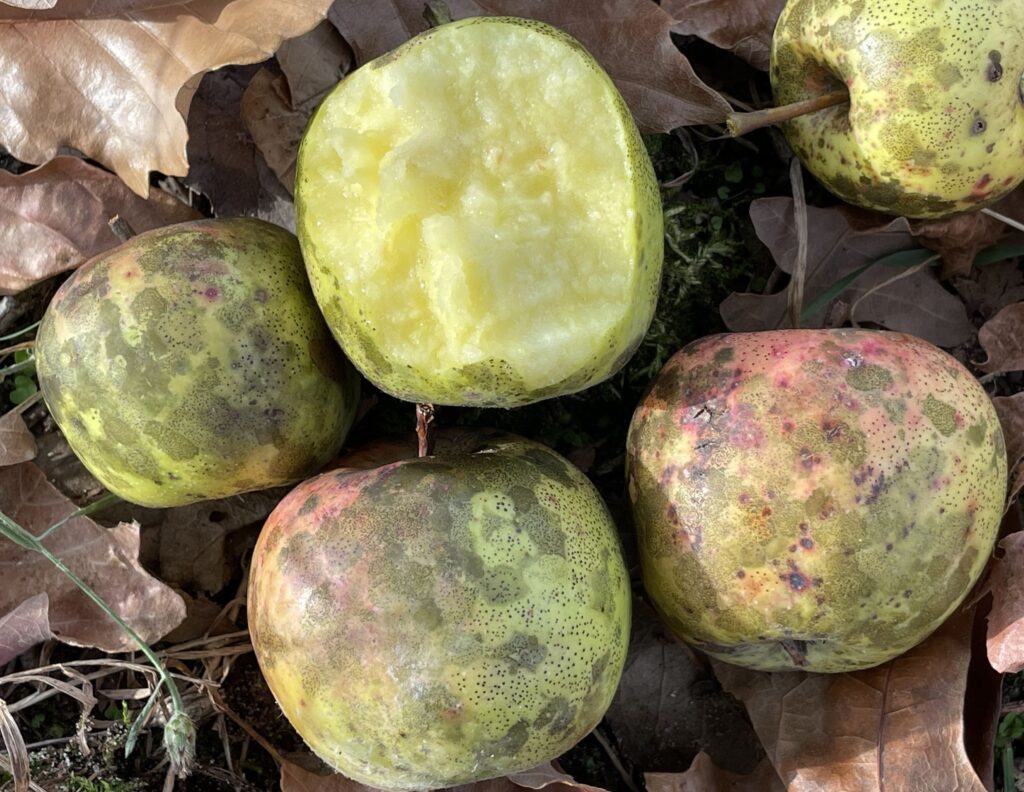
Antonovka apple is used for both rootstock and apple production for super hardiness and great processing apple. My seed source combines the native crab cross Heterophylla with the original Russian apple which is similar in many ways to the Northern Spy. One of the most productive seedling full sized apple on my farm. Not pretty I know, but certainly the aroma is amazing. I only have two trees of this at my farm. The other is a a delicious large striped apple which has very clean foliage but has been a shy bearing tree so far.
The days of having a few seed trees here and there is not good. My northern pecan trees came from the Northern Nut Growers Association (John Gordon, Gary Fernald and Douglas Campbell) are now gone in their original habitat due to flooding on the Mississippi in the eighties. These were the wild trees collected as seed trees for short season northern areas. Seeds have to be used and spread outside their native ranges and put into some sort of cultivation even if it is not formally an orchard. This is the ideal application of new food crops self replicating and growing on their own within an ‘uncultivated’ ecosystem in the same way wild apples are found along a road. Bred by honeybees, distributed by birds and small mammals and maintained by deer and storms that is the perfect apple. In many ways it has to be thought of like a bridge or a building. It becomes much more than the sum of its parts. Certainly it is not thought of as native or non-native. Ecological integration is the key to this evolutionary transformation.
To me its amazing what nurseries can do with so little resources. They are very efficient in many ways. Relying on a labor force to collect seed that does it to get some exercise and fresh air and a bit of financial incentive is not enough if we plan to make a go of it on a bigger scale. To take this one step further would be to have seedling plantings which we could draw from a wider range of selections as well as creating populations in new areas. This not only preserves the selections but makes it possible for the populations to evolve over time via the forces of nature. The forces of nature are actual real world situations that plants have to go through to not only survive but be productive and healthy for its future generations. In this process the plants become native. Today it is often it just luck they survive and few people value them other than they are trees. In some ways it reminds me of my family’s abandoned Christmas tree farm. It’s beautiful and has value for the wildlife and for recreation. But the trees are no longer valued as Christmas trees. That ship has sailed. Instead the value is in the enjoyment of the land as it is now including the Scotch and Austrian pines. I hear there is a type of truffle you can grow on scotch pine roots. Maybe they would be perceived differently if that could be done.
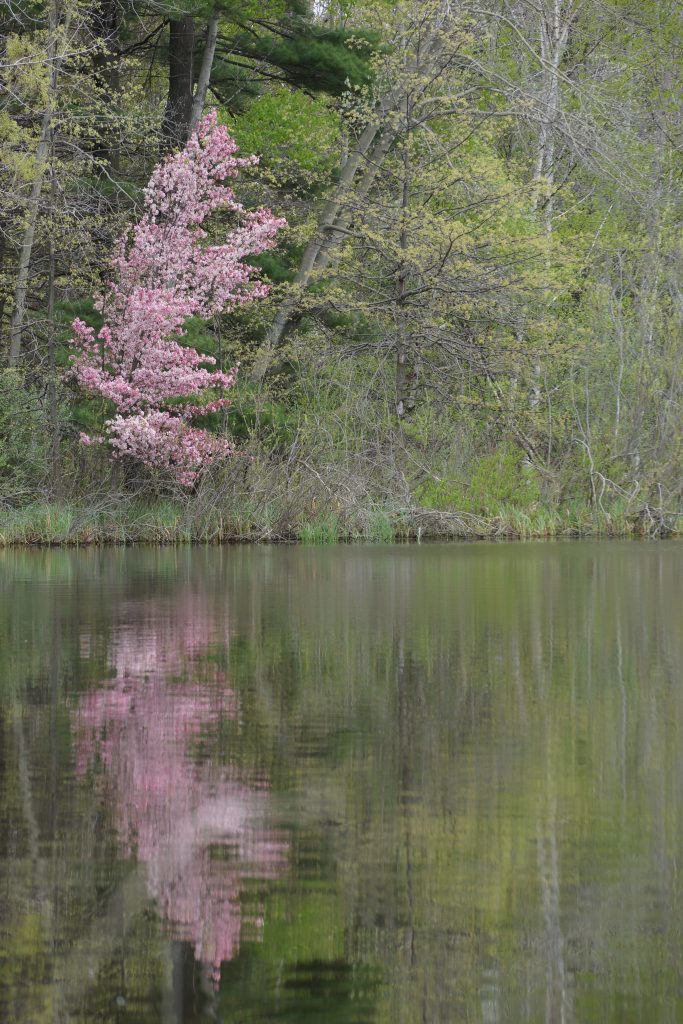
There is a great desire for new seed for new crops and a means to put these selections into production for both seed orchards and new varieties for the fruit, forestry and agricultural industries as well as permaculture and other self regenerative farming practices. Everyone wants new flavors, better nutrition and healthy foods. It is now becoming overwhelming in terms of interest. This is a challenge for all of us who want to bring this to fulfillment on a practical level. We will likely have to abandon some old ideas in the process. It cannot be experimental with some long drawn out breeding project. I would say the time is now. Let’s move but this time, lets do it together. It will be a lot easier.
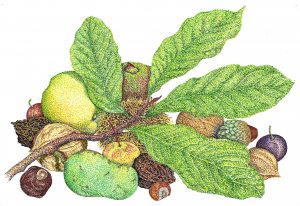
Enjoy. Kenneth Asmus
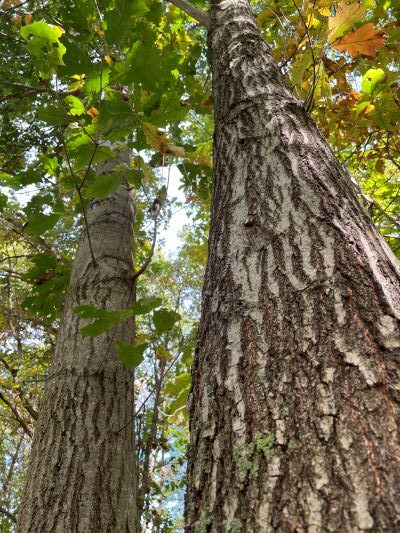
Red Willow Oak hybrid cross between Quercus phellos and Quercus rubra. Originally I found a willow oak in an arboretum planting where the parent tree was struggling to survive in a wind swept field. It rarely produced acorns and when it did, they were filled with weevils. Eventually one year came along and the acorns were more plentiful and clean. I planted several hundred of them and was able to create a population by winnowing down the population to seven of the most vigorous plants. Called Bartrams Oak, this is one of the most sought after hybrid red oaks. Quercus phellos x rubra